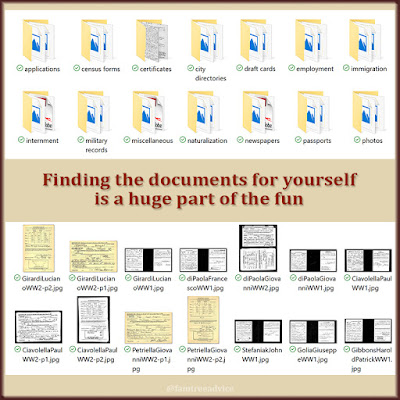You may have been born into citizenship. Your ancestor has another story.
If you have an immigrant ancestor, you may have some papers waiting for you. Has your family been in your country for a small number of generations? Then you may be able to find your ancestor's naturalization papers.
Naturalization and citizenship documents can offer a lot of hard facts. Say your immigrant had a spouse and kids when they filed for citizenship. You may find each family member's name and birth date/place listed out for you.
And you may find a card certifying the exact date your ancestor arrived, and the name of the ship that brought them. With that information, you have a much better chance of finding their ship manifest.
Yesterday I was paging through naturalization records looking for my grandfather. I have his papers, but I wanted to find a cleaner image from another source. (I found it.)
While searching, I saw a familiar name: Giovanni Antonio Basile. It gave his birth date. It gave his hometown—my Grandpa's hometown of Colle Sannita. He's in my family tree!
 |
| If you can find your ancestor's naturalization papers, you'll find a ton of facts. |
Here are the main facts from his papers:
- He was born in Colle Sannita on 22 Feb 1894. I have his birth record, but if I didn't, this would help.
- He arrived at Ellis Island on 15 Oct 1920 aboard the Adriatic. I already knew this, but imagine if I didn't. With the date and ship name, he can't hide.
- He lived in Ellwood City, Pennsylvania, and worked at a tube mill. That's interesting. He got here a month before Grandpa. But this is the same town and steel tube mill where my grandfather lived and worked at the very same time. Giovanni and Grandpa have the same 2 witnesses on their papers.
- He left for America not from Naples, but from Cherbourg, France. Grandpa did the same!
- His wife was Giovannina Galasso, born on 20 March 1900. This checks out. I have her birth record, too.
- His son Giorgio was born in Italy on 29 January 1921. This is new information. I knew Giorgio existed because I have his 1927 ship manifest when he came to America with his mom. I have him in the 1930 and 1940 censuses, too. But I never had his birth date, and 1921 Italian birth records are too recent to access. Armed with his birth date, I immediately found his obituary and military information.
Behold the power of naturalization records.
 |
| Some naturalization papers give you facts you can't find anywhere else. |
My grandfather's naturalization papers took me by surprise when I first saw them. I didn't know he was ever in western Pennsylvania. By this time he'd been in New York City, and with his uncle outside Boston. He may have followed some of his Italian townsmen to work at the steel tube mill.
Grandpa has one extra naturalization document that's different. It's a card with a handwritten date of 26 March 1952. The card repeats several facts about his naturalization, including:
- His 1927 Ellwood City, Pennsylvania, address
- His naturalization date of 24 February 1927
- The certificate, volume and document number of his naturalization. (His document number is 68535 while Giovanni's is 68525.)
The card also says he is now 49 years old (in 1952) and has been in Ohio for 1 year. That last fact is important to me. I was never sure exactly when he and my grandmother moved from New York to Ohio. It looks like it was 1951.
His signature is still a shocker to me. It's exactly like my father's signature, right down to the circles over the i's. I had to ask my father if he had forged it!
Finding your ancestor's naturalization papers is hard if you can't search an index. You need to know which district court they would have gone to. You need to know which year. And you may not find them.
I'm having no luck with my other grandfather. I do know which district court he would have gone to. And I can narrow the time frame down to 1925–1927. You see, all I've found is an index card with nothing but his name on it.
If you have very little to go on, consider this:
- The index card with his name on it is from a collection dated 1914–1927.
- He was in New York City from mid-1914 to mid-1915.
- He went back to fight in World War I for the Italian Army, so I doubt he'd applied for U.S. citizenship.
- He was a prisoner of war for a year and recovering for 2 years, so he didn't get back to America until 1920.
- His 1925 New York State Census says he's an alien.
Those facts narrow down the 1914–1927 index card collection to mid-1925–1927 for me. So far I've hurt my wrist clicking through 800 pages. That was about a week's worth of New York City naturalization papers!
If you need to do a manual search:
- Go to FamilySearch.org and Search the Catalog.
- Enter your ancestor's state
- On the results page, refine your search by clicking Keywords and entering Naturalization
- From there choose either naturalization and citizenship or the index.
- To figure out the right district, Google those in the list (such as Ohio Southern District Court). See if they covered your ancestor's town.
- When you've got that, keep clicking your options. Hopefully you'll have a long list of choices, each labelled with a date range, document range, or town name.
Then, start clicking through the pages. And clicking. And clicking. If you find your ancestor, I promise your wrist will stop hurting.



